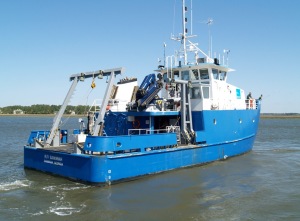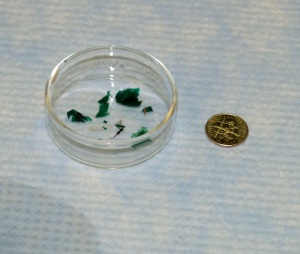Professor Jay Brandes wrote this report from a short research cruise to the Gulf Stream this past weekend.
This last Friday-Saturday, I had the opportunity to tag along with a group of 15 K-12 teachers and Dr. Marc Frischer, who was leading them on a cruise out to the Gulf Stream. It was to be the highlight of a weeklong intensive workshop on ocean literacy for the teachers, and the first time that many of them had been on a ship out of sight of land.
I came along to do a little preliminary reconnaissance for possible traces of oil and for plastics in the South Atlantic Bight region.
There has been a considerable amount of concern about oil being carried by the Gulf Stream / Loop Current (see previous posts) from the Deepwater Horizon Spill. While no satellite imagery or other data has suggested that large amounts of oil has reached the Gulf Stream, it is always possible that smaller amounts could have been carried into the current.
Thus it makes sense to take a look for oil traces. Given the timeframe of the cruise (leaving at 4 pm Friday, getting back at midnight Saturday night) there wouldn’t be enough time to conduct an exhaustive survey. However, there was enough time to do a few quick tows. In addition, I wanted to see how much plastic contamination might be out there. Most of us have seen the reports on the “great Pacific Garbage Patch”, and there is a lesser one out in the middle of the North Atlantic as well. But little data exists for out coastal waters.
Unlike the sheets of oil seen in the Gulf, the oil reaching our region is expected to be weathered and broken up into smaller pieces, called tar balls. If they are widely spread out, as expected, then the best and fastest way to collect them (or search for them) is to use what is called a “neuston” net. Neuston refers to organisms living at the sea surface. Such a net is designed be towed behind or beside the research vessel, right at the surface. Scientists also have used such nets to collect floating plastics in the ocean.
We conducted four surveys, towing our net for a half hour in the middle of the Gulf Stream, its edge, the outer shelf, and the middle shelf. We found no tar balls or other oil residues in any of the samples, which was a relief. While I have to caution that these were just small surveys (the net is only 2 meters wide by 1 deep), and it is a big ocean, the lack of any sign of oil is at least a positive sign.
However, the same could not be said about plastics. We found small plastic pieces in all of our net samples, ranging from 1-2 mm size tiny particles to larger pieces a few cm across. One would not see these in looking out from a boat, unlike the big pieces found in the “garbage patches”. But they are of a size that will interfere with marine organisms, because they can be ingested.
Overall, the levels of plastics were low, and I feel that I can describe our offshore environment as relatively pristine, from this standpoint. It is up to all of us to keep it that way.




